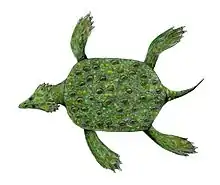Westphaliasaurus
Westphaliasaurus is an extinct genus of plesiosaur from Lower Jurassic (Pliensbachian stage) deposits of Westphalia, northwestern Germany. It is known from a nearly complete and articulated skeleton missing the skull and about 38% of the upper neck vertebrae. It was found by Sönke Simonsen, an amateur paleontologist, in 2007 from the Höxter district near Bielefeld, in the east of North Rhine-Westphalia, Germany. It was first named by Leonie Schwermann and Martin Sander in 2011 and the type species is Westphaliasaurus simonsensii. The generic name is derived from the latinized name for Westfalen, Westphalia and lizard, saurus. The specific name honors Sönke Simonsen. Estimates suggest that it was about 4.5 m (15 ft) long and weighed 400 kg (880 lb).[1][2]
| Westphaliasaurus Temporal range: Early Jurassic, | |
|---|---|
 | |
| Scientific classification | |
| Domain: | Eukaryota |
| Kingdom: | Animalia |
| Phylum: | Chordata |
| Class: | Reptilia |
| Superorder: | †Sauropterygia |
| Order: | †Plesiosauria |
| Family: | †Microcleididae |
| Genus: | †Westphaliasaurus Schwermann & Sander, 2011 |
| Type species | |
| †Westphaliasaurus simonsensii Schwermann & Sander, 2011 | |
References
- Leonie Schwermann; Martin Sander (2011). "Osteologie und Phylogenie von Westphaliasaurus simonsensii: Ein neuer Plesiosauride (Sauropterygia) aus dem Unteren Jura (Pliensbachium) von Sommersell (Kreis Höxter), Nordrhein-Westfalen, Deutschland [=Osteology and Phylogeny of Westphaliasaurus simonsensii, a new plesiosaurid (Sauropterygia) from the Lower Jurassic (Pliensbachian) of Sommersell (Höxter district), North Rhine-Westphalia, Germany]". Geologie und Paläontologie in Westfalen. 79 (1): 56 pp. ISBN 978-3-940726-14-8.
- Paul, Gregory S. (2022). The Princeton Field Guide to Mesozoic Sea Reptiles. Princeton University Press. pp. 170–171. doi:10.1515/9780691241456. ISBN 9780691193809. S2CID 251553177.






.png.webp)